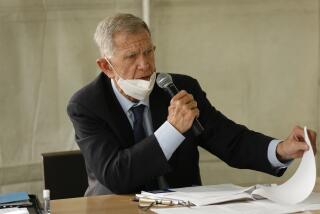City Officials Defend 1989 Sweep of Civic Center
- Share via
SANTA ANA — In a departure from the first trial held in the case of a homeless man who accuses the city of violating his civil rights, Mayor Daniel H. Young and other top officials testified Wednesday in defense of Santa Ana’s treatment of “vagrants” and said they never adopted policies to drive the homeless out of the city.
The appearances in Superior Court by Young, City Manager David N. Ream and City Atty. Edward J. Cooper signaled the high stakes placed on the lawsuit brought by Mashone Bonner, 45, who alleges that the city illegally confiscated his possessions and threw them away during a sweep of the Civic Center in 1989.
The lawsuit is the only one of several similar suits filed against the city to be taken before a jury. The other cases were settled out of court, with the city paying a total of about $500,000. Bonner is seeking unspecified damages.
The retrial of the Bonner lawsuit began last week, three days after another jury deadlocked over the issue of whether the city had properly posted warnings about the disposal of abandoned property at Civic Center and how to reclaim it.
In addition to testimony by top city officials, jurors in the second trial have heard other evidence not presented during the first one, including information about the previous settlements and about an August, 1990, sweep through the Civic Center in which more than 60 people were arrested for offenses ranging from littering to jaywalking.
The city’s attorney, Phillip D. Eaton, has tried to show that Bonner--who won $22,000 in a previous settlement--had enough money to replace his lost property.
Bonner’s attorney, Christopher B. Mears, has argued that the “false arrest” sweep--as well as the confiscation of Bonner’s property and other city actions--demonstrate a concerted effort to drive the homeless out of Santa Ana.
The cornerstone of Mears’ case is a series of city staff memos written in 1988 by Allen E. Doby, Recreation and Community Services Agency executive director, and by then-Deputy City Manager Jan C. Perkins, concerning the creation of a “vagrancy task force” among city staff members.
Doby’s memo said the City Council had developed a policy that “the vagrants are no longer welcome” in Santa Ana. The next day, Perkins responded with an action plan for the task force and said its “mission” was to move vagrants and their belongings out of the city.
During their testimony, the mayor, city manager and city attorney said the council had not adopted a policy concerning the homeless.
“Did the City Council in 1988 or 1989 ever adopt a policy that vagrants were no longer welcome in the city of Santa Ana?” Eaton asked.
“Absolutely not,” Ream testified.
Ream also called the Doby memo “ridiculous” and said it was a “silver bullet” that had cost the city hundreds of thousands of dollars to settle other cases brought by homeless people.
After the memo surfaced as part of other litigation, Doby was told in the fall of 1989 to write another memo stating that a City Council policy did not exist, Ream testified.
But Ream said he could not remember whether he asked Doby why he wrote the first memo or whether he took issue at the time with Perkins’ characterization of the task force’s “mission” in her memo or in a newspaper account regarding the city’s efforts to clean up the Civic Center.
Ream also testified that he did not know in advance of the 1990 homeless roundup at Civic Center, which he called an independent police operation.
Mayor Young was asked about a July, 1989, newspaper interview in which he said the city had to clean up the bedrolls of the homeless “and let them know this is not the place to go.”
Young elaborated to the jury: “We are not going to stop picking up the hypodermic needles, we are not going to stop picking up the open sewage in the parks, we are not going to stop picking up the lice-infested bedrolls that are there.”
He called the vagrancy issue “one hellacious problem” and said he is frustrated that the lawsuits have thwarted city efforts to pick up items in parks that create unsafe and unhealthy conditions for the general public.
More to Read
Sign up for Essential California
The most important California stories and recommendations in your inbox every morning.
You may occasionally receive promotional content from the Los Angeles Times.













